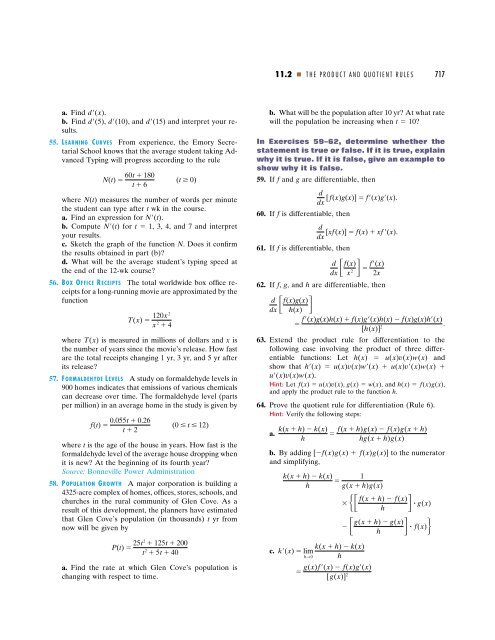11DIFFERENTIATION - Department of Mathematics
11DIFFERENTIATION - Department of Mathematics
11DIFFERENTIATION - Department of Mathematics
You also want an ePaper? Increase the reach of your titles
YUMPU automatically turns print PDFs into web optimized ePapers that Google loves.
a. Find d(x).<br />
b. Find d(5), d(10), and d(15) and interpret your results.<br />
55. L EARNING C URVES From experience, the Emory Secretarial<br />
School knows that the average student taking Advanced<br />
Typing will progress according to the rule<br />
60t 180<br />
N(t) <br />
t 6<br />
(t 0)<br />
where N(t) measures the number <strong>of</strong> words per minute<br />
the student can type after t wk in the course.<br />
a. Find an expression for N(t).<br />
b. Compute N(t) for t 1, 3, 4, and 7 and interpret<br />
your results.<br />
c. Sketch the graph <strong>of</strong> the function N. Does it confirm<br />
the results obtained in part (b)?<br />
d. What will be the average student’s typing speed at<br />
the end <strong>of</strong> the 12-wk course?<br />
56. B OX O FFICE R ECEIPTS The total worldwide box <strong>of</strong>fice receipts<br />
for a long-running movie are approximated by the<br />
function<br />
T(x) <br />
120x 2<br />
x 2 4<br />
where T(x) is measured in millions <strong>of</strong> dollars and x is<br />
the number <strong>of</strong> years since the movie’s release. How fast<br />
are the total receipts changing 1 yr, 3 yr, and 5 yr after<br />
its release?<br />
57. F ORMALDEHYDE L EVELS Astudy on formaldehyde levels in<br />
900 homes indicates that emissions <strong>of</strong> various chemicals<br />
can decrease over time. The formaldehyde level (parts<br />
per million) in an average home in the study is given by<br />
0.055t 0.26<br />
f(t) <br />
t 2<br />
(0 t 12)<br />
where t is the age <strong>of</strong> the house in years. How fast is the<br />
formaldehyde level <strong>of</strong> the average house dropping when<br />
it is new? At the beginning <strong>of</strong> its fourth year?<br />
Source: Bonneville Power Administration<br />
58. P OPULATION G ROWTH Amajor corporation is building a<br />
4325-acre complex <strong>of</strong> homes, <strong>of</strong>fices, stores, schools, and<br />
churches in the rural community <strong>of</strong> Glen Cove. As a<br />
result <strong>of</strong> this development, the planners have estimated<br />
that Glen Cove’s population (in thousands) t yr from<br />
now will be given by<br />
P(t) 25t2 125t 200<br />
t 2 5t 40<br />
a. Find the rate at which Glen Cove’s population is<br />
changing with respect to time.<br />
11.2 THE PRODUCT AND QUOTIENT RULES 717<br />
b. What will be the population after 10 yr? At what rate<br />
will the population be increasing when t 10?<br />
In Exercises 59–62, determine whether the<br />
statement is true or false. If it is true, explain<br />
why it is true. If it is false, give an example to<br />
show why it is false.<br />
59. If f and g are differentiable, then<br />
d<br />
[f(x)g(x)] f(x)g(x).<br />
dx<br />
60. If f is differentiable, then<br />
d<br />
[xf(x)] f(x) xf (x).<br />
dx<br />
61. If f is differentiable, then<br />
d<br />
dxf(x) x2 f(x)<br />
2x<br />
62. If f, g, and h are differentiable, then<br />
d<br />
dxf(x)g(x) h(x)<br />
f(x)g(x)h(x) f(x)g(x)h(x) f(x)g(x)h(x)<br />
<br />
[h(x)] 2<br />
.<br />
63. Extend the product rule for differentiation to the<br />
following case involving the product <strong>of</strong> three differentiable<br />
functions: Let h(x) u(x)v(x)w(x) and<br />
show that h(x) u(x)v(x)w(x) u(x)v(x)w(x) <br />
u(x)v(x)w(x).<br />
Hint: Let f(x) u(x)v(x), g(x) w(x), and h(x) f(x)g(x),<br />
and apply the product rule to the function h.<br />
64. Prove the quotient rule for differentiation (Rule 6).<br />
Hint: Verify the following steps:<br />
k(x h) k(x) f(x h)g(x) f(x)g(x h)<br />
a. <br />
h<br />
hg(x h)g(x)<br />
b. By adding [f(x)g(x) f(x)g(x)] to the numerator<br />
and simplifying,<br />
k(x h) k(x) 1<br />
<br />
h g(x h)g(x)<br />
f(x h) f(x)<br />
g(x)<br />
h<br />
g(x h) g(x)<br />
f(x)<br />
h<br />
k(x h) k(x)<br />
c. k(x) lim<br />
h0 h<br />
g(x)f(x) f(x)g(x)<br />
[g(x)] 2

















